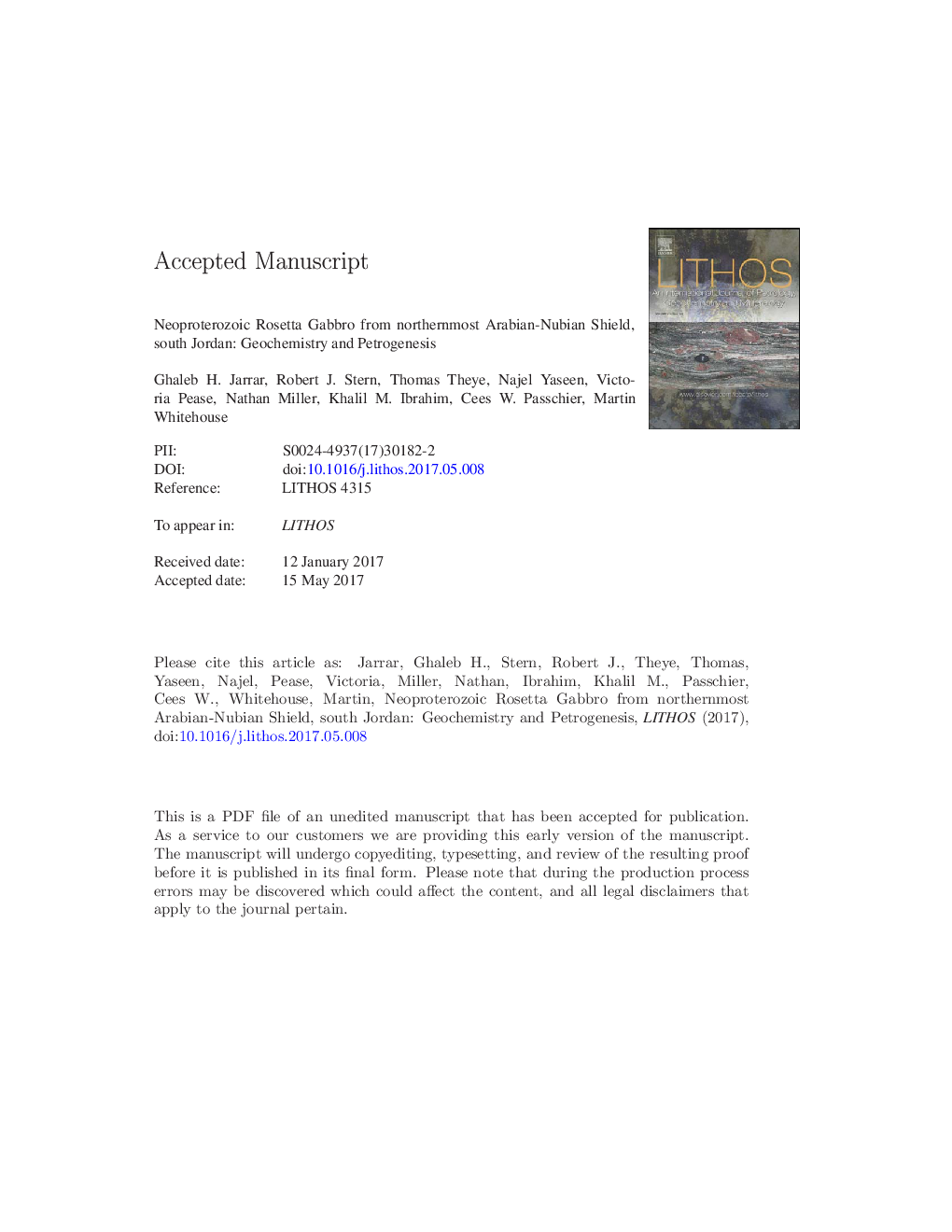| کد مقاله | کد نشریه | سال انتشار | مقاله انگلیسی | نسخه تمام متن |
|---|---|---|---|---|
| 5784057 | 1638630 | 2017 | 53 صفحه PDF | دانلود رایگان |
عنوان انگلیسی مقاله ISI
Neoproterozoic Rosetta Gabbro from northernmost Arabian-Nubian Shield, south Jordan: Geochemistry and petrogenesis
دانلود مقاله + سفارش ترجمه
دانلود مقاله ISI انگلیسی
رایگان برای ایرانیان
موضوعات مرتبط
مهندسی و علوم پایه
علوم زمین و سیارات
ژئوشیمی و پترولوژی
پیش نمایش صفحه اول مقاله

چکیده انگلیسی
An Ediacaran mafic intrusion of south Jordan is a distinctive appinitic igneous rock with a possibly unique texture, characterized by spherical clots up to 40 mm in diameter composed of amphibole cores from which plagioclase euhedra radiate; we call it the Rosetta Gabbro. It is exposed as a small (ca. 750 m2) outcrop in the Neoproterozoic basement of south Jordan. A second outcrop of otherwise similar gabbro is located about 400 m to the north of the Rosetta Gabbro, but it lacks the distinctive texture. The Rosetta Gabbro could represent a magma pipe. It intrudes the Aqaba Complex (~ 600 Ma) granitoids and metasediments of the Janub Metamorphic Complex (633-617 Ma). The gabbro is an Ol- to QZ tholeiite with the following chemical characteristics: SiO2 = 46.2-47.8 wt.%; Al2O3 = 16.4-17.7 wt.%, TiO2 = 1.70-2.82 wt.%, Na2O = 1.27-2.83 wt.%. K2O = 0.82-1.63 wt.%; Mg# 58-63; Σ REE = 70-117 ppm; La/Yb ~ 6 to 8; and Eu/Eu* = 1.05-1.2. The investigated gabbro has the geochemical features of a continental flood tholeiitic basalt emplaced in a within-plate tectonic setting. Two varieties of amphiboles are found: 1) large, 3-5 mm, brown ferri-titanian-tschermakite (K0.09Na0.28)(Na0.20Ca1.80)(Mn0.04Fe3 +1.1Mg2.34Fe2 +0.90Ti0.29Al0.22)(Al1.85Si6.15)O22(OH)1.95 of the calcic amphibole group which is riddled with opaques; and 2) acicular yellowish-light green ferrian-magnesiohornblende (K0.04Na0.153)(Ca1.755Na0.245) (Fe3 +0.66Mn0.01Fe2 +1.01Mg3.03Ti0.06Al0.22)(Al1.03Si6.97)O22(OH)1.95. Scattered flakes of phlogopite also occur. Tabular radiating plagioclase (An64-79) are complexly twinned, with broad lamellae that show no zoning. Laser-ablation ICP-MS analyses of amphibole and plagioclase reveal considerable variation in trace element abundance, in spite of more subtle major element variations except for TiO2 in amphibole. The REE in the amphibole shows an order of magnitude variation with a concave-downward pattern and a positive Eu anomaly Eu/Eu* = 0.6-2, though far less pronounced compared to the Eu/Eu* = 5-45 of plagioclase. The 3D dandelion-like texture of the rosettas is broadly similar to “Chrysanthemum Stone”, which is a diagenetic growth in sedimentary rock, but we can find no description of similar textures in igneous rocks. The formation of the rosettas is thought to reflect loss of magmatic water resulting in supersaturation of plagioclase, which grew rapidly around amphibole and may have floated in the magma. This implies magmatic evolution in shallow (10 to 12 km deep) crust where temperatures were nevertheless in the range of ca. 750 to 900 °C.
ناشر
Database: Elsevier - ScienceDirect (ساینس دایرکت)
Journal: Lithos - Volumes 284â285, July 2017, Pages 545-559
Journal: Lithos - Volumes 284â285, July 2017, Pages 545-559
نویسندگان
Ghaleb H. Jarrar, Robert J. Stern, Thomas Theye, Najel Yaseen, Victoria Pease, Nathan Miller, Khalil M. Ibrahim, Cees W. Passchier, Martin Whitehouse,